Casa de la Cultura (House of Culture)
A place which offers interesting culture... and a rich historical heritage!
The House of Culture, as defined by its name, is a place dedicated to promoting cultural and artistic activities. From dance, music and cinema to literature and paintings. This is the place to visit if you want to see concerts and exhibitions, but at the same time you can experience an important historical heritage.
In this short (well actually rather long) article I will talk about all the things you can find here :)
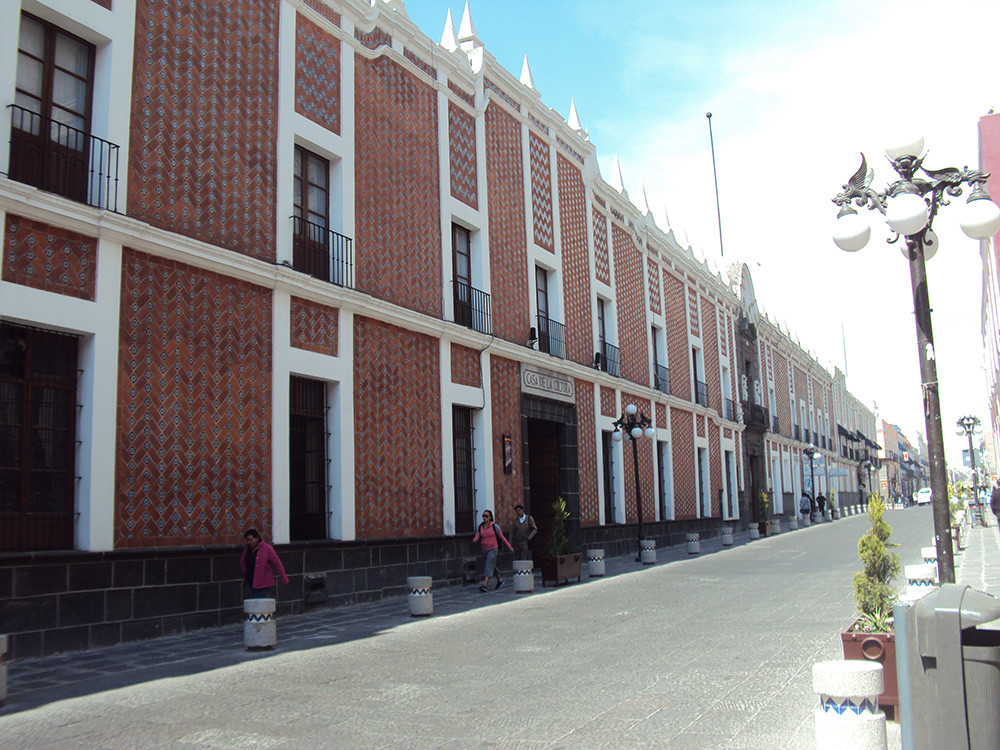 The street where you will find the House of Culture is called 'La calle 5 Oriente'. Now I look at it more carefully, I really like the red brick facade :) (photo taken from: http://www.laculturaenpuebla.org/wp-content/uploads/2013/03/Casa-de-la-Cultura.jpg)
The street where you will find the House of Culture is called 'La calle 5 Oriente'. Now I look at it more carefully, I really like the red brick facade :) (photo taken from: http://www.laculturaenpuebla.org/wp-content/uploads/2013/03/Casa-de-la-Cultura.jpg)
A little history...
The building itself dates back to the 16th century. Initially, it was called 'Colegio de San Juan' (San Juan School). Some time afterwards, it became a seminary.
In contemporary times, it had various uses, such as a government office and even a post office. (Now I remember, the current post office is in the same block... I think it would be interesting to find out more about the history of the buildings in the centre of Puebla :) ).
The building
With regard to its architecture, it has a red brick facade and when you go inside, you can see the grand main patio which is surrounded by offices and agencies of the place. Looking at the photos, I have just remembered that before, they had little metal tables and chairs you could use if you wanted some peace and quiet. But since quite a few years ago, they took them away, I don't know why.
So, if you go inside (not on one of the days when they hold events), you'll have to stand for the entire duration of your visit because if you attempt to sit down on one of the windowsills or door-frames, one of the guards will quickly approach you to tell you to get off... I know, it makes sense! We all know that doing this could irreversibly damage historic buildings :p No, but seriously, no joking, I'm only telling you this so that you don't go and do it and get told off. -.
By the way, the House of Culture is a very big building. So big that it not only has one entrance, but two. The main entrance is on '5 Oriente' street which is behind the Cathedral. You have to go through that door if you're going to one of the concerts or organised events, or if you want to visit the famous Palafoxiana Library, for example. Whereas, the entrance on '7 Oriente' street is designated for those who are attending workshops there. (I have been to two of them! :D).
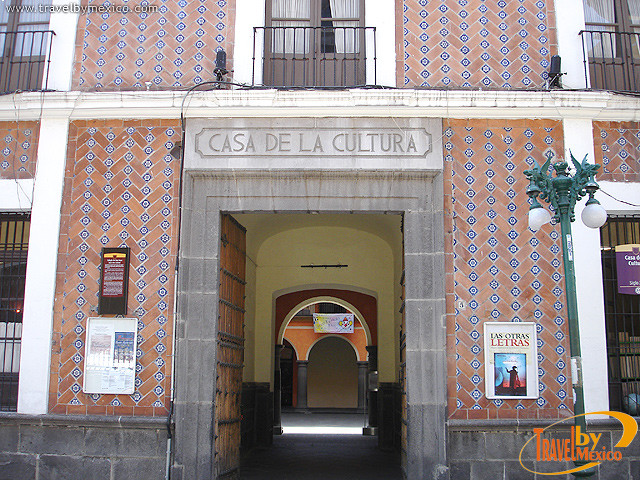 The red brick facade is also decorated with blue 'talavera poblana' tiles (photo taken from: http://www.travelbymexico.com/blog/imgBase/2009/05/Colegio-san-juan-casa-de-cultura-Puebla.jpg)
The red brick facade is also decorated with blue 'talavera poblana' tiles (photo taken from: http://www.travelbymexico.com/blog/imgBase/2009/05/Colegio-san-juan-casa-de-cultura-Puebla.jpg)
A rich historical heritage
Being such an old building, it's normal that it stands out, and not only because of its shows and cultural events which take place there. Below I will talk about two parts of the House of Culture which make up its important historical heritage:
The Palafoxiana Library
I would love to talk in more detail about this place, but that would make for another article. For now, all I will say is that this place is home to the personal collection of the bishop Juan de Palafox y Mendoza (one of the most important people of the city of Puebla, in the viceregal period). Here you will find more than forty thousand old books about different topics, and even in other languages (like French).
Something I find really interesting is that Juan de Palafox y Mendoza made a donation to this important heritage so that anyone who wanted to be educated, had access to knowledge. In addition, he made it a condition that the building could be accessed by the general public, and not only communities of the church (and as we know, in that time they were practically the only ones who had access to knowledge... those communities and the nobles that is).
But anyway, leaving that information to one side, the Palafoxiana Library stands out not only for its historical importance, but also because the actual room is a true work of art from the baroque period. I won't stop to give you more details about this, as you can see for yourself. The entrance fee costs $30 (a little less than two euros).
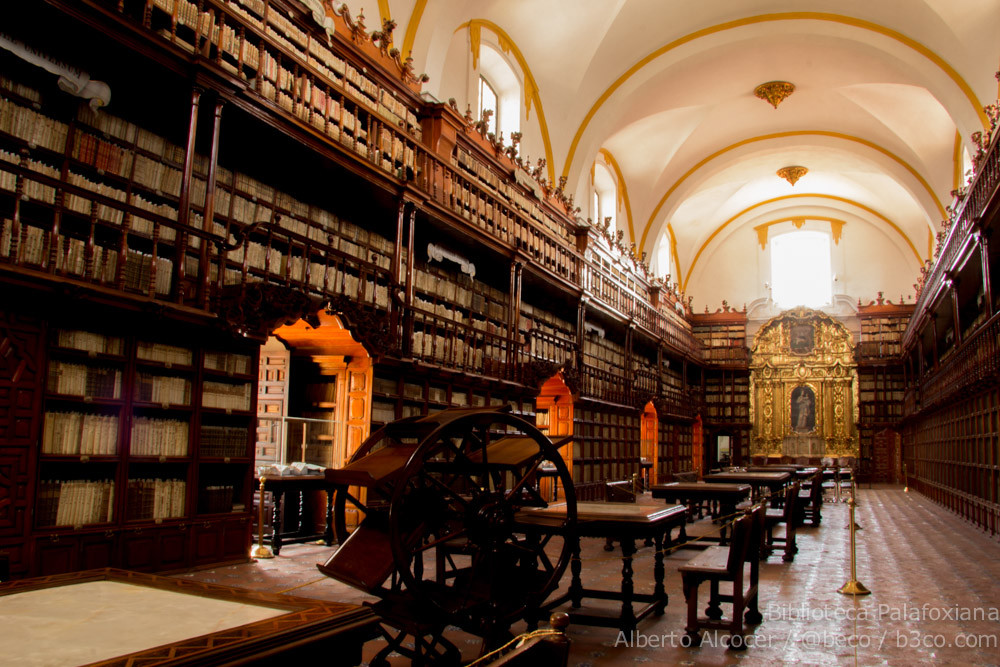 Here I present to you the Palafoxiana Library! You can see the baroque furniture and the altarpiece. You can't say that you don't want to go inside;) (photo taken from: http://b3co.com/wp-content/uploads/2013/07/IMG_3503.jpg)
Here I present to you the Palafoxiana Library! You can see the baroque furniture and the altarpiece. You can't say that you don't want to go inside;) (photo taken from: http://b3co.com/wp-content/uploads/2013/07/IMG_3503.jpg)
And even if you decide not to go in, when you go to the House of Culture and go up to the first floor, you can see this place from outside. You can see its old furniture and bookshelves as well as its beautiful altarpiece.
To tell you the truth, I've never been inside to see it, but only because there was a classical music concert on at the time during the International Festival of Puebla. (But here I have to be judgemental and say that, although it's a beautiful setting, the Palafoxiana isn't the best place for this kind of event because the acoustics aren't the best...nothing beats the acoustics of the church, which were developed purely for this purpose, but anyway!... )
A historic treasure, unknown to many...
For those who don't know, the French Emperor Napoleon III tried to invade Mexico. This isn't widely known in France (of course, you don't teach students about historical defeats :p), but it's one of the most important historical facts about Mexico, especially the city of Puebla. It was on 5th May 1862 when the French troops were defeated by the heroic lines of Zacapoaxtla soldiers.
This invasion of the French Empire in reality wasn't supported by the nation's village. Victor Hugo, the great politician and writer, even wrote a letter to Mexico to express his solidarity, in the middle of this armed conflict.
You may ask yourself, "what does this have to do with the House of Culture? O. o" A lot actually! Because this is the place where you can find Victor Hugo's bust and above all, you can read the content of the missive written by him.
It isn't the original letter (I'm not sure where that can be found. -. ), but the large plaque engraved in golden letters. I recently spoke about that in one of my Spanish classes and I managed to find a picture of the plaque. I had already read the text before (and more than once!), but the last time I read it, I was touched once again.
Honestly, I find it admirable that Victor Hugo put nationalism to one side to lay the foundations for solidarity. The most remarkable sentence in the letter is: "But either way you win or be defeated, France will continue to be your sister, sister in your glory or your misery [... ]".
All in all, if you want to read the entire letter, you need to go to the House of Culture. You have to go through the main entrance, on '5 Oriente' street. Go to the patio and walk towards the right, you'll see it on the wall.
 The letter to the city of Puebla by Victor Hugo...amazing! (photo taken from: http://www.scoopnest.com/es/user/JLozanoA/574273506944253952)
The letter to the city of Puebla by Victor Hugo...amazing! (photo taken from: http://www.scoopnest.com/es/user/JLozanoA/574273506944253952)
What can you do in the House of Culture?
Now that I think of it, it offers a wide range of uses: from exhibitions and workshops, to concerts and conferences. Perhaps not everything is as interesting, but I think that from time to time it's good to take a look at its events calendar. On some occasions there are events which are really worthwhile. Every time I went, I always took a copy of the programme for the month. It's completely free and you can get your copy from the "welcome stand" at the entrance on the right.
Library
The House of Culture also has a public library whose heritage is dedicated to literature. I remember that when I was in sixth form, I went there to borrow a book I needed for a subject. It was a novel called "La sombra del caudillo" (The shadow of the strongman), by Martín Luis Guzman.
It's a historical novel set in the era after the Mexican Revolution. After publication, it was even banned in Mexico as it was, in turn, a criticism of the government. However, nowadays no work of art is censored, so if you want to read you can go to the library in the House of Culture; )
Workshops
Amongst all the activities going on in this place, there are many workshops which you can get involved in. There are workshops for children, teenagers and adults. You can do workshops in dance, drawing, chess, music, public speaking, recitals, etc. You can also learn the Nahautl language and photography, for example.
Fees are very cheap in comparison with other places: $530 a term. The workshops last for four months and are four hours a week. I have just checked their page and I saw that the new term for the spring courses start on 11th April. If you want to know more information about this, here is the link to the page:
http://www.talleres.puebla.gob.mx/
By the way, as I previously mentioned, I have been to one of the workshops in the House of Culture ^^ but mine wasn't on drawing or music, it was on costume jewellery. Basically, we learnt how to make necklaces, bracelets and other fantastic jewellery with beads, pearls, etc. I took the course for two terms, when I was at secondary school.
At the beginning, I got so into it that I asked my Mum to buy me some pearls and beads in eeeevveerryy colour :P However, in the end I didn't buy any, because I didn't produce anything major x) No, jewellery making didn't turn out to be my passion :P All in all, you can find something that you're into on their current events calendar ^^
 I know this photo doesn't have much to do with the workshops :p But it's just to show you that in the House of Culture, they organise a gift competition every year, on the occasion of one of the most beautiful traditions: The Day of the Dead. If only I could go back in time to see them myself! :) (Photo taken from: http://www.periodicoenfoque.com.mx/wp-content/uploads/2014/10/Ofrendas-Casa-cultura.jpg)
I know this photo doesn't have much to do with the workshops :p But it's just to show you that in the House of Culture, they organise a gift competition every year, on the occasion of one of the most beautiful traditions: The Day of the Dead. If only I could go back in time to see them myself! :) (Photo taken from: http://www.periodicoenfoque.com.mx/wp-content/uploads/2014/10/Ofrendas-Casa-cultura.jpg)
Painting and Photography exhibitions
In the House of Culture there are also galleries from the exhibitions. So here you can appreciate the work of some photographers and painters. Also, they have 'large format' exhibitions set up in the corridors of the building. When the masterpieces are set up in one of the exhibition rooms, generally speaking, it's free to go in^^
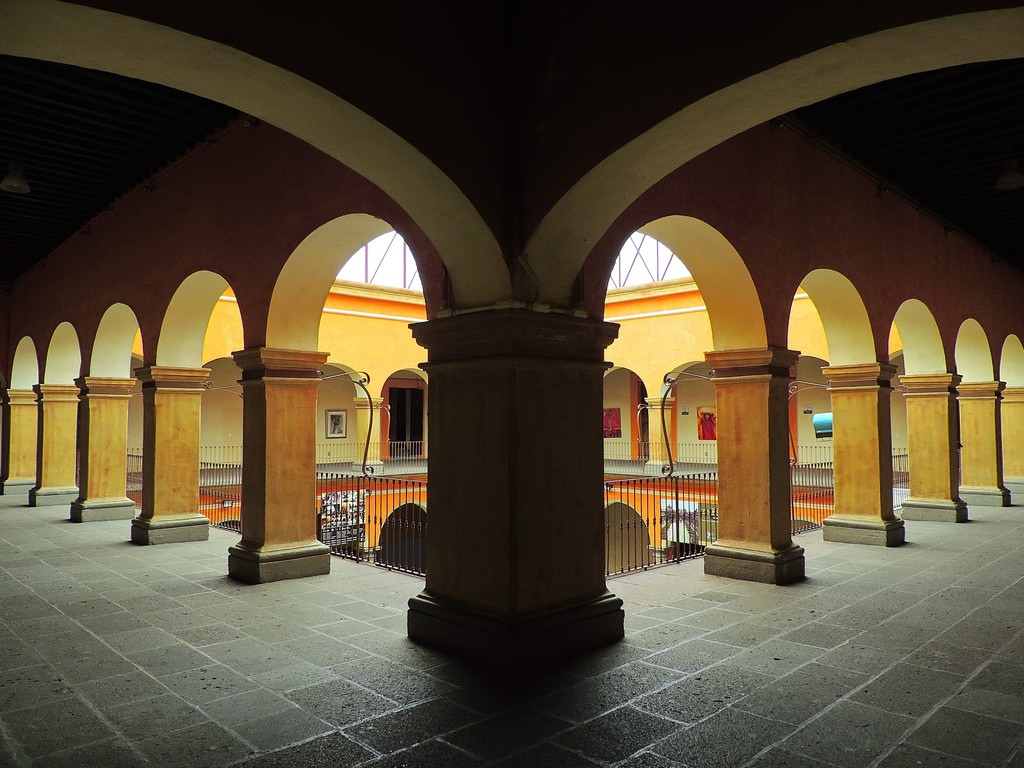 This is on the top floor of the House of Culture. In these corridors, sometimes there are exhibitions of photographs (in fact, if you look closely, you can see some pictures at the back ^^) (Photo taken from: https://upload.wikimedia.org/wikipedia/commons/3/38/Casa_de_cultura,_puebla.JPG)
This is on the top floor of the House of Culture. In these corridors, sometimes there are exhibitions of photographs (in fact, if you look closely, you can see some pictures at the back ^^) (Photo taken from: https://upload.wikimedia.org/wikipedia/commons/3/38/Casa_de_cultura,_puebla.JPG)
Luis Buñuel filmography
You can also watch films in the House of Culture. There is a small cinema called Luis Buñuel, a tribute to this great filmmaker. There are always screenings and they are often free. In the event of there being a fee, it isn't expensive. It's very cheap compared to commercial cinemas.
Mind you, you won't find the most recent films :P This Luis Buñuel cinematic experience focuses on spreading cinema of the arts, so much as Mexican to foreign films. There are different series. I remember there was an Asian cinema series and another series dedicated to films about the First World War. I also noticed that they constantly screen anime films.
I've been to this place a few times. I went to see "Nosferatu" (yeah, you know, the black and white film about the vampire... I think cinema lovers would get angry with me if they read that I'm speaking about this film like this :P). I also went to see the film called "Goodbye Lenin" (it's a German film which I loved :) ) and another called "Joyeux Noël" (Merry Christmas) (I also loved this film. It's a French film based on a very moving real life story during the First World War).
In short, this is just to give you an idea of what the Luis Buñuel filmography has to offer. I think that it's a place where you can find many masterpieces which wouldn't be screened in conventional cinemas. Although the room is small and sometimes it isn't equipped with the latest technology, I think that it's something that shouldn't be overlooked as it makes a valuable contribution :)
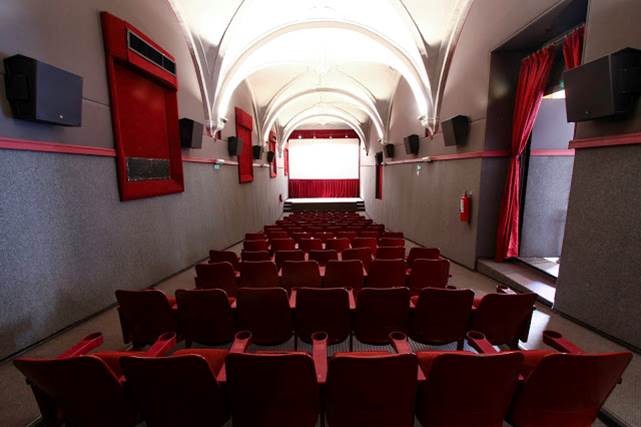 The Luis Buñuel cinematic room. I know it's small, but its programme is really worth looking at :) (Photo taken from: http://sic.gob.mx/galeria_imagen/52dc4fb60060dcines.jpg)
The Luis Buñuel cinematic room. I know it's small, but its programme is really worth looking at :) (Photo taken from: http://sic.gob.mx/galeria_imagen/52dc4fb60060dcines.jpg)
Conferences
I remember that when I checked the monthly programme of the House of Culture, I saw there were conferences on different topics: from round-table conferences on history and politics to literary talks and book presentations. I went to a book presentation and it was about caricatures from the Revolution era. It was very interesting, but in the end we didn't buy it because it seemed too expensive :(
Dance and music shows
Here you can also enjoy many free events. Every week there are concerts by the Town Orchestra, as well as other groups. There's always a great atmosphere at these music events! I remember that, at a number of them, when there was a track you could dance to, couples would always get up and dance to the music... wow, it's something to enjoy! Until now, I have rarely seen any spontaneity like this in France :P
Also, every weekend there's a folklore dance show by the company called "Que chula es Puebla" (How cool is Puebla?) (I think that's what it's called. -. ). Although it isn't the Amalia Hernández ballet, it's still a great opportunity to go and enjoy yourself and find out a little more about Mexican traditions :) In addition, there you can also see the traditional dance group from my secondary school, 'General no. 9'. The group is called "Macuilzóchitl" and not only can you see teenagers from that school perform, but also from other schools.
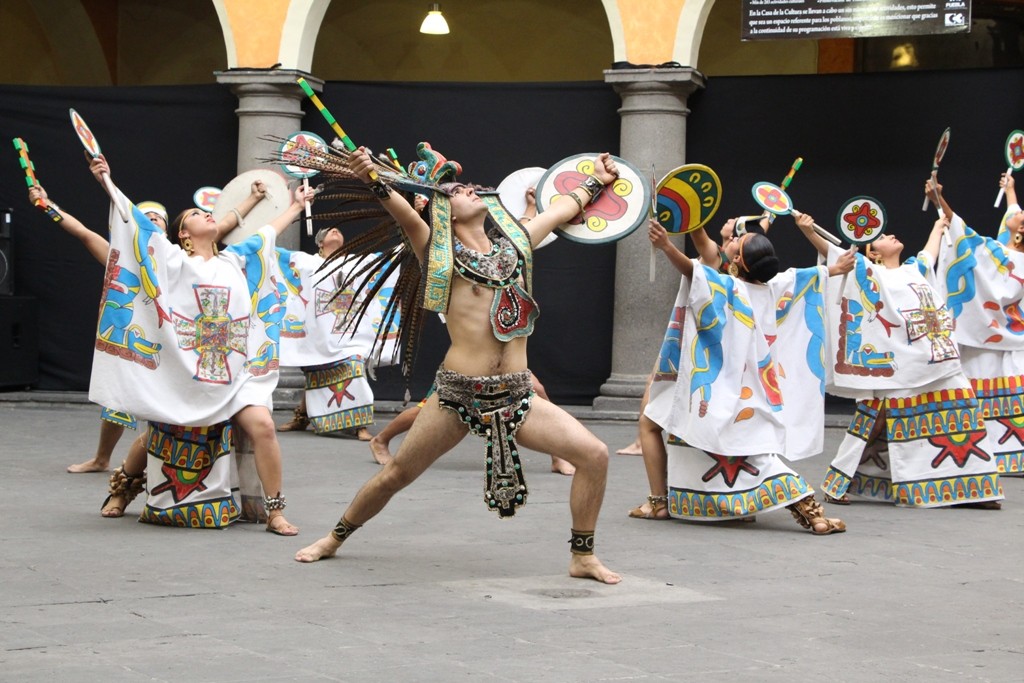 An example of one of the groups who perform in the patio in the House of Culture. Here, they are interpreting a pre-Hispanic dance, dressed up in costumes from that era (Photo taken from: http://www.mexicoescultura.com/galerias/actividades/principal/img_1242_1.jpg)
An example of one of the groups who perform in the patio in the House of Culture. Here, they are interpreting a pre-Hispanic dance, dressed up in costumes from that era (Photo taken from: http://www.mexicoescultura.com/galerias/actividades/principal/img_1242_1.jpg)
 Not only can you see folklore dances here, but also Polynesian dances (just like in the photo), Hawaiian, Arabic, Modern, Jazz, etc... The House of Culture opens its doors to diverse forms of artistic expression! (Photo taken from: http://www.mexicoescultura.com/galerias/actividades/principal/danza_polinesia_5.jpg)
Not only can you see folklore dances here, but also Polynesian dances (just like in the photo), Hawaiian, Arabic, Modern, Jazz, etc... The House of Culture opens its doors to diverse forms of artistic expression! (Photo taken from: http://www.mexicoescultura.com/galerias/actividades/principal/danza_polinesia_5.jpg)
And the opening hours?
Well, as the House of Culture has different offices, you'll have to check the corresponding opening hours for each office. For example, the Palafoxiana Library is open from Tuesdays to Sundays from 10.00a. m. to 5.00p. m. (at weekends they close at 4.00p. m. ). Whereas the Luis Buñuel cinema has screenings at 6.00p. m. and 7.00p. m.
So check beforehand (or just ask) to make sure, depending on what you want to go and see or do ^^
Conclusion
The House of Culture should be a must on your 'to do list' in the city of Puebla... You have to go more than once! Because this place offers a rich historical heritage (like the Palafoxiana Library or the plaque showing the letter by Victor Hugo), but also here you can enjoy different events. From workshops, to cinema series, to conferences and of course, concerts and dance shows.
All this, within a few streets in the heart of the city :) Therefore, leaving here you can continue exploring the streets, with no problems, following the beauty and history of it.
Photo gallery
Content available in other languages
Rate and comment about this place!
Do you know Casa de la Cultura (House of Culture)? Share your opinion about this place.
























